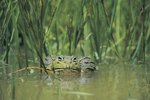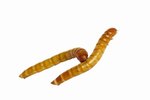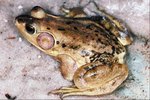
Cricket frogs are a small group of wee amphibians from the eastern portion of North America. These water-loving frogs are in no way related to insects, but their courtship vocalization style is reminiscent of the sounds that crickets make. Some of the most prominent cricket frog types are the northern cricket frog (Acris crepitans), southern cricket frog (Acris gryllus) and Blanchard's cricket frog (Acris crepitans blanchardi).
Captive Lifespan
In captive settings, cricket frogs can sometimes stay alive for five or so years, according to scientist Joshua Elliott of Argonne National Laboratory. Cricket frogs are comparably diminutive amphibians, and bigger frogs often live for significantly longer periods of time.
Wild Lifespan
The typical cricket frog lifespan out in the wild is extremely brief -- much shorter than its captive counterpart. These diurnal frogs tend to survive for a short four months or so while in their natural settings. In northern cricket frogs, a mere 5 percent of all individuals get past the cold winter months alive, according to the Minnesota Department of Natural Resources. Not even 1 percent of these frogs, however, make it into the next autumn. It is extremely common for tadpoles to pass away before attaining maturity. The rare but lucky specimens that become adults can sometimes reach more than a year in age.
Reproductive Populations
Out in the wild, there have been documented instances in which Blanchard cricket frogs' autumn reproductive populations were made up almost 100 percent by the juveniles of the same year -- no surviving adults at all, according to Michael C. MacDonald and Richard M. Lehtinen of the College of Wooster's biology division. These frogs' lifespans are so brief that it's realistic for some groups of them to totally change in just 16 months.
Population Risks
Regional populations of cricket frogs are often highly susceptible to extinction as a result of their usually short lives, according to the website for the Wisconsin Department of Natural Resources. In parts of their geographic scope, such as Wisconsin, cricket frog lifespans are occasionally at risk due to factors like pests, water drainage in agricultural sites and coastline expansion.
Diet
A captive cricket frog requires a proper diet in order to survive for as long as possible. These tiny frogs are natural insectivores and thrive when fed diets of bugs, bugs and more bugs -- particularly small ones. Some key dietary staples for cricket frogs are mosquitoes, leafhoppers, flies, beetles and ants. They also feed on spiders. As tadpoles, however, these little amphibians feed mostly on phytoplankton, which is an aquatic plant also often referred to as "microalgae."
Living Environment
An optimal living environment is also essential for promoting a longer lifespan in captive cricket frogs. They thrive in ranges of 65 to 75 degrees Fahrenheit. Their enclosures need ample plants and hiding spots. Little pools of water are also necessary. It's vital to change out the pool water at least once a day.
References
- Amphibian Declines; Michael J. Lannoo
- Argonne National Laboratory Newton Ask a Scientist: Frog Lifespan
- Michigan Natural Features Inventory: Acris crepitans blanchardi
- University of Michigan Animal Diversity Web: Acris crepitans
- Minnesota Department of Natural Resources: Acris crepitans
- Wisconsin Department of Natural Resources: Northern Cricket Frog
- University of Michigan Animal Diversity Web: Acris gryllus
- Academia.edu: Life Fast, Die Young? A Six-Year Field Study of Longevity and Survivorship in Blanchard's Cricket Frog
- Frogs and Toads - Your Happy Healthy Pet; Steve Grenard
Photo Credits
-
Jupiterimages/Photos.com/Getty Images




